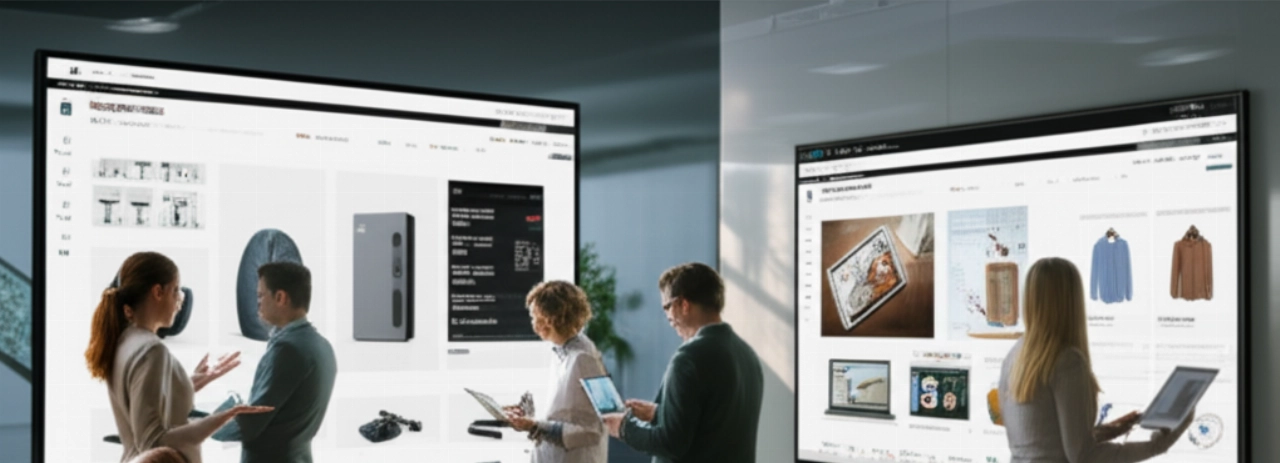In the relentless pursuit of market dominance, many enterprise organizations find themselves grappling with a fragmented digital empire. Multiple brands, each with its own e-commerce platform, operating in isolated silos. This isn't just an inconvenience; it's a strategic liability. It’s the scalability ceiling that prevents unified growth, the integration hell that drains resources, and the performance bottleneck that stifles customer experience.
You’re not just managing websites; you’re managing complex ecosystems. The challenge isn't merely about launching another storefront; it's about orchestrating a cohesive, high-performance digital strategy across your entire portfolio. This is where the strategic implementation of a multi-brand ecommerce platform becomes not just an option, but a critical imperative for synchronized growth.
At Commerce-K.com, we understand this intricate dance of brand identity, operational efficiency, and technological prowess. This guide is your definitive roadmap to transforming your disparate digital assets into a unified, powerful engine that drives exponential growth and operational synergy across all your brands. We don't just build platforms; we engineer a cohesive, high-performance ecosystem.

Beyond the Silos: Why a Multi-Brand Ecommerce Platform is Your Strategic Imperative
Imagine a world where every new product launch, every marketing campaign, and every customer interaction across your brand portfolio is amplified by shared intelligence and streamlined operations. This isn't a pipe dream; it's the reality enabled by a well-architected multi-brand ecommerce platform.
The traditional approach of stand-alone platforms for each brand leads to:
- Duplicated Efforts: Redundant infrastructure, separate teams, and repetitive processes inflate your Total Cost of Ownership (TCO).
- Inconsistent Customer Experience: Disjointed journeys across brands erode trust and loyalty.
- Data Fragmentation: A lack of a unified customer view hinders personalized marketing and strategic decision-making.
- Scalability Limitations: Each platform hits its own scalability ceiling, making portfolio-wide growth unpredictable and costly.
A unified multi-brand ecommerce platform transforms these liabilities into assets. It centralizes core functionalities like product information management (PIM integration), order management, customer data (CRM integration), and inventory (ERP integration), while allowing for distinct brand experiences on the frontend. This strategic consolidation fosters operational efficiency, reduces TCO, and provides a singular, powerful data source for informed business intelligence. It’s about building a competitive moat that your rivals cannot easily replicate.

Engineering Synergy: Key Pillars of a High-Performance Multi-Brand Architecture
Building a successful multi-brand ecommerce platform isn't about choosing a single software; it's about architecting a flexible, robust ecosystem. Our approach centers on principles that ensure long-term scalability and adaptability:
- Composable Commerce & MACH Architecture: We champion a composable commerce approach, leveraging MACH architecture (Microservices, API-first, Cloud-native, Headless). This allows you to select best-of-breed components for specific needs (e.g., a powerful PIM, a flexible CMS, a specialized pricing engine) and integrate them seamlessly via APIs. This modularity is crucial for managing diverse brand requirements without being constrained by a "one-size-fits-all" trap.
- Centralized Data Management: A robust PIM integration is non-negotiable. It ensures consistent, accurate product data across all brands, simplifying content updates and enriching product discovery. Similarly, centralizing customer and order data through deep ERP integration and CRM integration provides a single source of truth, enabling personalized experiences and efficient order fulfillment.
- Flexible Frontend Experiences: While the backend is unified, each brand needs its unique identity. Headless commerce allows for complete creative freedom, enabling distinct storefronts, unique branding, and tailored user experiences for each brand, all powered by the same scalable backend. This is vital for maintaining brand equity while leveraging shared infrastructure.
- Advanced B2B Capabilities: For enterprises with both B2B and B2C operations, the platform must support complex B2B workflows, including custom pricing, tiered accounts, quote management, and self-service portals. A truly multi-brand solution can often manage both models from a single, integrated backend.
This architectural blueprint provides the agility to adapt to market changes, integrate new technologies, and scale effortlessly as your portfolio expands, eliminating the dreaded performance bottleneck.

The Fragmented Future: Avoiding the Pitfalls of Disconnected Multi-Brand Strategies
The allure of quick, inexpensive solutions often leads enterprises down a path of increasing technical debt and operational chaos. Opting for disparate, basic platforms for each brand might seem cost-effective initially, but it inevitably leads to a fragmented future.
- The "Off-the-Shelf" Trap: Standard SaaS platforms, while easy to deploy, often become too restrictive for complex enterprise needs. Custom pricing models, intricate product configurators, or unique B2B workflows quickly expose their limitations, forcing costly workarounds or hindering innovation. This is the essence of the "one-size-fits-all" trap.
- Integration Hell Revisited: Without a unified strategy, every new system (ERP, PIM, WMS, CRM) becomes another point of failure. Manual data synchronization, broken APIs, and inconsistent information become the norm, leading to operational nightmares and significant hidden costs.
- The Fear of a Failed Migration: When the inevitable need to upgrade or consolidate arises, the prospect of migrating multiple, disconnected platforms is terrifying. The risk of lost SEO rankings, data corruption, and catastrophic downtime looms large. A strategic, unified approach mitigates this by planning for future transitions from the outset.
Our expertise lies in foreseeing these challenges and engineering solutions that proactively address them. We don't just build; we de-risk your investment, ensuring your multi-brand ecommerce platform is a foundation for growth, not a source of constant firefighting.
From Complexity to Clarity: Partnering with Commerce K for Your Multi-Brand Vision
The difference between a vendor and a partner is profound. A vendor sells you a product; a partner understands your strategic vision, anticipates your challenges, and engineers a solution that delivers measurable ROI. At Commerce-K.com, we embody this partnership philosophy.
Our team comprises senior architects, seasoned strategists, and expert developers who have navigated the complexities of enterprise digital transformation for global brands. We don't just implement technology; we craft bespoke commerce engines designed to:
- Unify Your Ecosystem: Consolidate disparate systems into a cohesive, high-performance multi-brand ecommerce platform.
- Optimize Performance & Scalability: Engineer architectures that handle peak traffic, complex transactions, and exponential growth without breaking a sweat.
- Mitigate Risk: Employ battle-tested methodologies for seamless integrations and migrations, ensuring business continuity and data integrity.
- Future-Proof Your Investment: Build flexible, composable commerce solutions that evolve with your business, not against it, minimizing future replatforming cycles and reducing Total Cost of Ownership (TCO).
We translate your multi-brand aspirations into a tangible, high-performing reality, ensuring your digital commerce operations become a competitive advantage, not a source of technical debt.
Frequently Asked Questions about Multi-Brand Ecommerce Platforms
What are the primary benefits of consolidating multiple brands onto a single platform?
Consolidating onto a single multi-brand ecommerce platform offers significant benefits, including reduced operational costs (lower TCO), improved efficiency through centralized management of products and orders, consistent customer experiences across brands, and a unified data view for better analytics and decision-making. It also enhances scalability and simplifies future integrations.
How does a multi-brand platform handle unique brand identities and customer experiences?
A well-designed multi-brand ecommerce platform leverages a headless or composable commerce architecture. This allows for a single, powerful backend to manage all core commerce functionalities (PIM, ERP, order management) while enabling completely distinct, customized frontends for each brand. This ensures unique brand identity, design, and user experience, even as they share a common, efficient infrastructure.
What are the typical integration challenges, and how does Commerce K address them?
Common integration challenges include connecting ERP, PIM, CRM, and WMS systems, managing complex B2B workflows, and ensuring real-time data synchronization. Commerce K addresses these by employing an API-first approach, building robust custom connectors, and leveraging middleware solutions. Our deep expertise in complex enterprise systems ensures seamless, automated data flow, eliminating integration hell.
How can we ensure SEO continuity and data integrity during a multi-brand migration?
Ensuring SEO continuity and data integrity during a multi-brand ecommerce platform migration is paramount to avoid the fear of a failed migration. Commerce K employs a meticulous, phased migration strategy that includes comprehensive SEO audits, 301 redirect mapping, content migration planning, and rigorous data validation. We prioritize minimal downtime and a seamless transition to protect your existing search rankings and valuable customer data.
Is a multi-brand solution suitable for B2B and B2C operations simultaneously?
Absolutely. Many modern multi-brand ecommerce platforms are designed to support both B2B and B2C models from a single, integrated backend. They offer distinct functionalities for each, such as personalized pricing, quote management, and self-service portals for B2B, alongside streamlined consumer checkout processes for B2C. This unified approach simplifies management and leverages shared resources across all business segments.
Your Future-Proof Commerce Engine Starts Here
You've navigated the complexities of managing multiple brands, each with its unique challenges. You understand that true digital transformation isn't about incremental fixes but about strategic, foundational change. The insights shared here illuminate a path from fragmented operations to a unified, high-performance multi-brand ecommerce platform that truly drives synchronized growth.
Perhaps you're thinking, "This sounds like a massive undertaking," or "Do we have the internal resources for such a strategic shift?" These are valid concerns, and precisely why a partnership with Commerce K is invaluable. We don't just provide solutions; we provide the expertise, the methodology, and the proven track record to de-risk your investment and ensure a successful outcome.
Stop navigating technical debt and operational silos. Your business deserves a clear digital commerce roadmap that delivers measurable results across your entire portfolio. The first step isn't a quote; it's a no-obligation Scoping & Strategy Session with our senior architects. We'll help you map your potential, identify key opportunities, and de-risk your investment. Click here, tell us about your project, and discover the synchronized growth opportunities you're currently missing. Start building your future-proof commerce engine today.
Further Reading:





